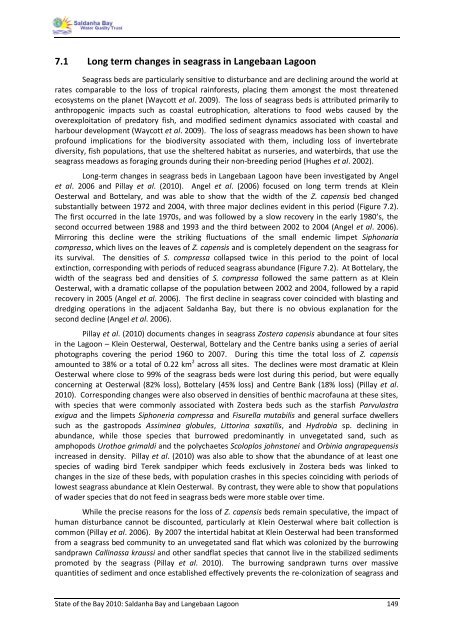State of the Bay Report 2010-Final - Anchor Environmental
State of the Bay Report 2010-Final - Anchor Environmental
State of the Bay Report 2010-Final - Anchor Environmental
You also want an ePaper? Increase the reach of your titles
YUMPU automatically turns print PDFs into web optimized ePapers that Google loves.
7.1 Long term changes in seagrass in Langebaan Lagoon<br />
Seagrass beds are particularly sensitive to disturbance and are declining around <strong>the</strong> world at<br />
rates comparable to <strong>the</strong> loss <strong>of</strong> tropical rainforests, placing <strong>the</strong>m amongst <strong>the</strong> most threatened<br />
ecosystems on <strong>the</strong> planet (Waycott et al. 2009). The loss <strong>of</strong> seagrass beds is attributed primarily to<br />
anthropogenic impacts such as coastal eutrophication, alterations to food webs caused by <strong>the</strong><br />
overexploitation <strong>of</strong> predatory fish, and modified sediment dynamics associated with coastal and<br />
harbour development (Waycott et al. 2009). The loss <strong>of</strong> seagrass meadows has been shown to have<br />
pr<strong>of</strong>ound implications for <strong>the</strong> biodiversity associated with <strong>the</strong>m, including loss <strong>of</strong> invertebrate<br />
diversity, fish populations, that use <strong>the</strong> sheltered habitat as nurseries, and waterbirds, that use <strong>the</strong><br />
seagrass meadows as foraging grounds during <strong>the</strong>ir non-breeding period (Hughes et al. 2002).<br />
Long-term changes in seagrass beds in Langebaan Lagoon have been investigated by Angel<br />
et al. 2006 and Pillay et al. (<strong>2010</strong>). Angel et al. (2006) focused on long term trends at Klein<br />
Oesterwal and Bottelary, and was able to show that <strong>the</strong> width <strong>of</strong> <strong>the</strong> Z. capensis bed changed<br />
substantially between 1972 and 2004, with three major declines evident in this period (Figure 7.2).<br />
The first occurred in <strong>the</strong> late 1970s, and was followed by a slow recovery in <strong>the</strong> early 1980’s, <strong>the</strong><br />
second occurred between 1988 and 1993 and <strong>the</strong> third between 2002 to 2004 (Angel et al. 2006).<br />
Mirroring this decline were <strong>the</strong> striking fluctuations <strong>of</strong> <strong>the</strong> small endemic limpet Siphonaria<br />
compressa, which lives on <strong>the</strong> leaves <strong>of</strong> Z. capensis and is completely dependent on <strong>the</strong> seagrass for<br />
its survival. The densities <strong>of</strong> S. compressa collapsed twice in this period to <strong>the</strong> point <strong>of</strong> local<br />
extinction, corresponding with periods <strong>of</strong> reduced seagrass abundance (Figure 7.2). At Bottelary, <strong>the</strong><br />
width <strong>of</strong> <strong>the</strong> seagrass bed and densities <strong>of</strong> S. compressa followed <strong>the</strong> same pattern as at Klein<br />
Oesterwal, with a dramatic collapse <strong>of</strong> <strong>the</strong> population between 2002 and 2004, followed by a rapid<br />
recovery in 2005 (Angel et al. 2006). The first decline in seagrass cover coincided with blasting and<br />
dredging operations in <strong>the</strong> adjacent Saldanha <strong>Bay</strong>, but <strong>the</strong>re is no obvious explanation for <strong>the</strong><br />
second decline (Angel et al. 2006).<br />
Pillay et al. (<strong>2010</strong>) documents changes in seagrass Zostera capensis abundance at four sites<br />
in <strong>the</strong> Lagoon – Klein Oesterwal, Oesterwal, Bottelary and <strong>the</strong> Centre banks using a series <strong>of</strong> aerial<br />
photographs covering <strong>the</strong> period 1960 to 2007. During this time <strong>the</strong> total loss <strong>of</strong> Z. capensis<br />
amounted to 38% or a total <strong>of</strong> 0.22 km 2 across all sites. The declines were most dramatic at Klein<br />
Oesterwal where close to 99% <strong>of</strong> <strong>the</strong> seagrass beds were lost during this period, but were equally<br />
concerning at Oesterwal (82% loss), Bottelary (45% loss) and Centre Bank (18% loss) (Pillay et al.<br />
<strong>2010</strong>). Corresponding changes were also observed in densities <strong>of</strong> benthic macr<strong>of</strong>auna at <strong>the</strong>se sites,<br />
with species that were commonly associated with Zostera beds such as <strong>the</strong> starfish Parvulastra<br />
exigua and <strong>the</strong> limpets Siphoneria compressa and Fisurella mutabilis and general surface dwellers<br />
such as <strong>the</strong> gastropods Assiminea globules, Littorina saxatilis, and Hydrobia sp. declining in<br />
abundance, while those species that burrowed predominantly in unvegetated sand, such as<br />
amphopods Urothoe grimaldi and <strong>the</strong> polychaetes Scoloplos johnstonei and Orbinia angrapequensis<br />
increased in density. Pillay et al. (<strong>2010</strong>) was also able to show that <strong>the</strong> abundance <strong>of</strong> at least one<br />
species <strong>of</strong> wading bird Terek sandpiper which feeds exclusively in Zostera beds was linked to<br />
changes in <strong>the</strong> size <strong>of</strong> <strong>the</strong>se beds, with population crashes in this species coinciding with periods <strong>of</strong><br />
lowest seagrass abundance at Klein Oesterwal. By contrast, <strong>the</strong>y were able to show that populations<br />
<strong>of</strong> wader species that do not feed in seagrass beds were more stable over time.<br />
While <strong>the</strong> precise reasons for <strong>the</strong> loss <strong>of</strong> Z. capensis beds remain speculative, <strong>the</strong> impact <strong>of</strong><br />
human disturbance cannot be discounted, particularly at Klein Oesterwal where bait collection is<br />
common (Pillay et al. 2006). By 2007 <strong>the</strong> intertidal habitat at Klein Oesterwal had been transformed<br />
from a seagrass bed community to an unvegetated sand flat which was colonized by <strong>the</strong> burrowing<br />
sandprawn Callinassa kraussi and o<strong>the</strong>r sandflat species that cannot live in <strong>the</strong> stabilized sediments<br />
promoted by <strong>the</strong> seagrass (Pillay et al. <strong>2010</strong>). The burrowing sandprawn turns over massive<br />
quantities <strong>of</strong> sediment and once established effectively prevents <strong>the</strong> re-colonization <strong>of</strong> seagrass and<br />
<strong>State</strong> <strong>of</strong> <strong>the</strong> <strong>Bay</strong> <strong>2010</strong>: Saldanha <strong>Bay</strong> and Langebaan Lagoon 149

















